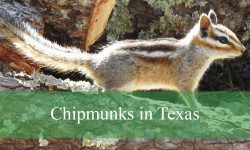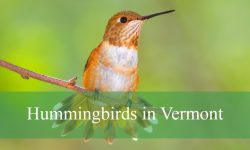Missouri’s diverse mix of woodlands, prairies, rivers, and suburban areas makes it an ideal home for many bird species throughout the year. Whether you live in the city, countryside, or somewhere in between, it’s easy to spot a colorful variety of feathered visitors right outside your window. From brilliant cardinals to chattering chickadees, backyard birds in Missouri bring life and sound to every season.
Backyard birds in Missouri are not only beautiful but also fascinating to observe. Many species can be attracted with simple bird feeders, native plants, or even a shallow birdbath. Watching their behaviors—from singing and nesting to feeding their young—offers a relaxing and rewarding way to connect with nature just steps from your home.
In this guide, you’ll discover 25 of the most common and recognizable backyard birds in Missouri. Each species is described with identifying features, behavior tips, and habitat preferences to help you better recognize them in your own yard.
Common Backyard Birds Found in Missouri
Eastern Bluebird
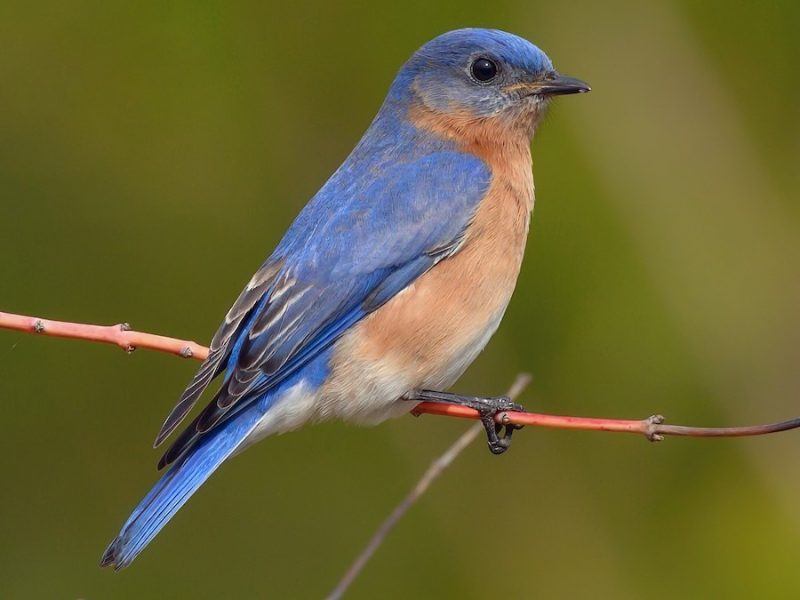
The Eastern Bluebird is a small, vibrant bird with brilliant sky-blue plumage on the back and head, contrasted by a rusty-red chest and white belly. Females are duller in coloration but still display hints of blue and red. Their cheerful appearance and soft warbling song make them a favorite among birdwatchers.
These birds are cavity nesters and readily accept nest boxes placed in open fields or along fences. They feed on insects and berries, often seen perched on wires or fence posts scanning for prey. During the breeding season, they become more vocal and territorial.
Eastern Bluebirds are widespread throughout Missouri’s countryside, parks, and large backyards, especially where nest boxes are provided. They prefer open habitats with scattered trees and are permanent residents in most of the state, particularly within USDA zones 5 through 7.
Northern Cardinal
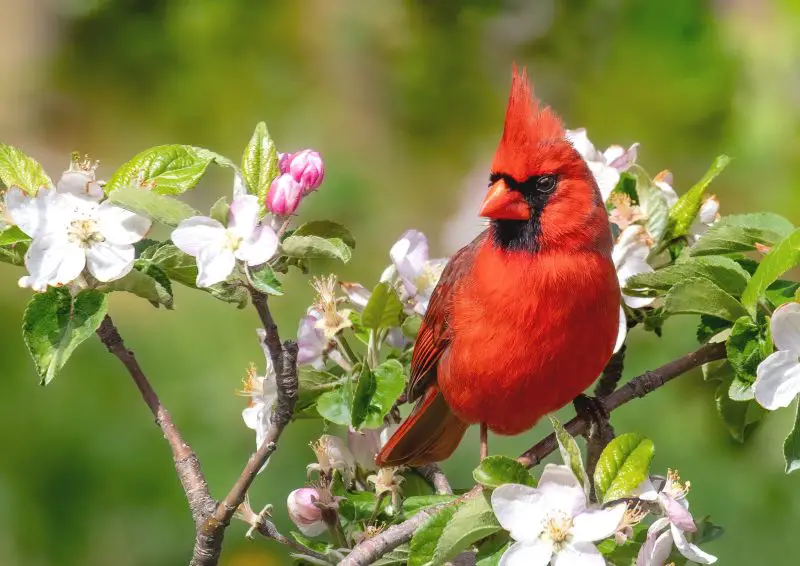
The Northern Cardinal is one of the most iconic birds in Missouri, instantly recognizable by its vivid coloring. Males are a brilliant red with a black mask across the face, while females are a warm brown with hints of red on the wings and tail. Both sexes have a prominent crest on their head and a thick orange bill.
These birds are known for their clear, whistling songs which can be heard throughout the day, especially at dawn and dusk. Northern Cardinals are territorial, often seen in pairs, and they stay in Missouri year-round. Their presence adds a splash of color even during the snowy months.
Northern Cardinals prefer dense shrubs, woodland edges, and backyards with plenty of cover for nesting. They are very common across Missouri and regularly visit feeders, particularly those filled with sunflower seeds. Their range spans USDA hardiness zones 5 through 7.
American Robin
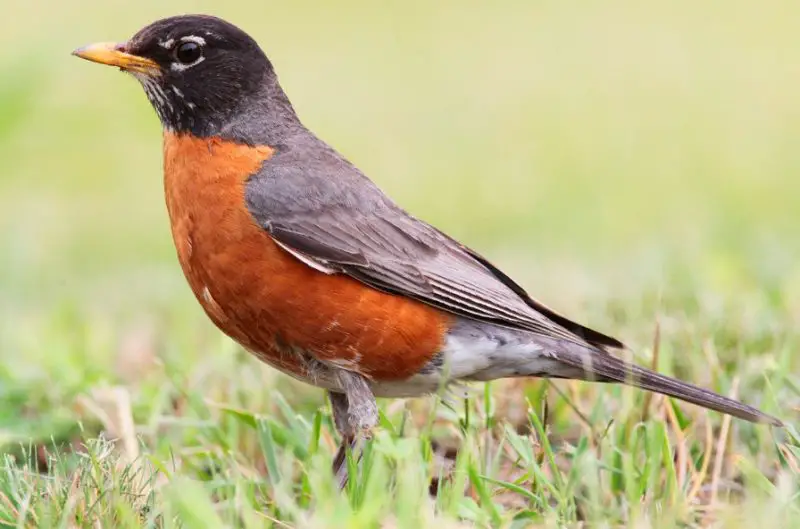
The American Robin is a familiar sight in Missouri and often signals the arrival of spring. This medium-sized bird has a dark gray back, orange-red breast, white under-tail, and a yellow bill. Its upright stance and cheerful appearance make it easy to identify in yards and parks.
Robins are ground foragers, frequently seen hopping across lawns in search of worms and insects. They are highly active during the breeding season and are among the first birds to begin singing in the morning. Their call is a series of cheerful, whistling phrases.
These birds build cup-shaped nests in trees, on ledges, or even on outdoor light fixtures. Robins are found throughout Missouri, especially in areas with open lawns and scattered trees. While many migrate south in winter, some remain if food like berries is available.
Blue Jay
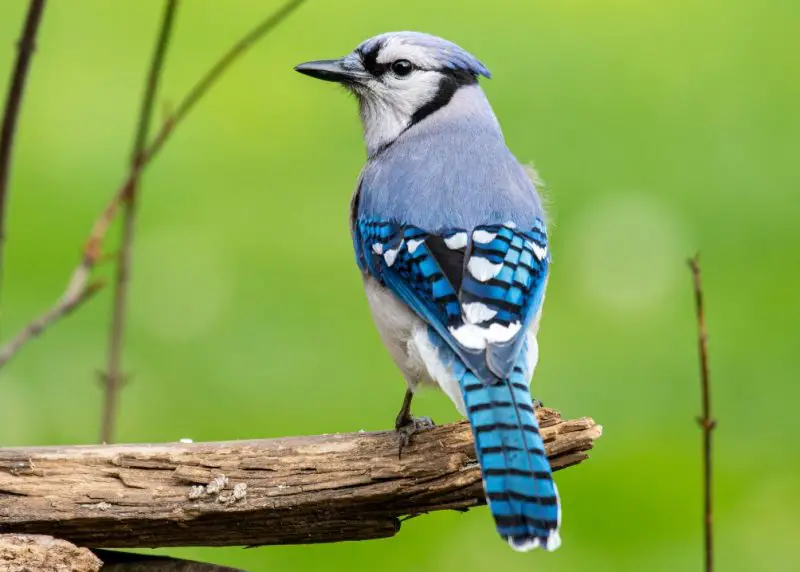
The Blue Jay is a striking bird with bright blue feathers, a white chest, and black accents around the face and neck. It has a noticeable crest and a loud, assertive voice. Measuring about 11 inches long, this bird often stands out in any backyard setting.
Blue Jays are intelligent and bold. They mimic hawk calls to scare away other birds and are known to raid nests for eggs or young. They also store acorns and help with forest regeneration. Despite their aggressive behavior, they are fascinating to watch.
They are common year-round residents in Missouri, especially in wooded suburbs and neighborhoods with mature trees. Blue Jays prefer oak forests and mixed woodlands, and they thrive in USDA zones 5 and 6 throughout the state.
Carolina Wren
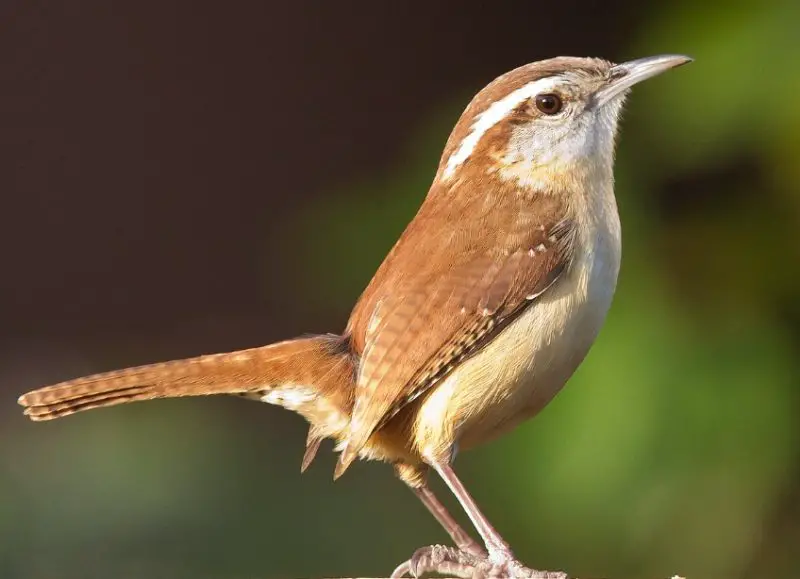
The Carolina Wren is a small, round bird with rich cinnamon coloring, a buff underside, and a prominent white eyebrow stripe. Though only about 5.5 inches long, it has a powerful voice and lively personality. Its upright tail adds to its animated appearance.
This wren is best known for its loud and repetitive song, which sounds like “teakettle-teakettle-teakettle.” It sings in all seasons and is often heard before it’s seen. Carolina Wrens are curious and frequently explore woodpiles, garages, and porch corners.
They favor brushy habitats, forest edges, and backyards with dense vegetation. These wrens are year-round residents in Missouri and adapt well to both urban and rural settings. They are commonly found throughout the state in USDA zones 6 and 7.
Mourning Dove
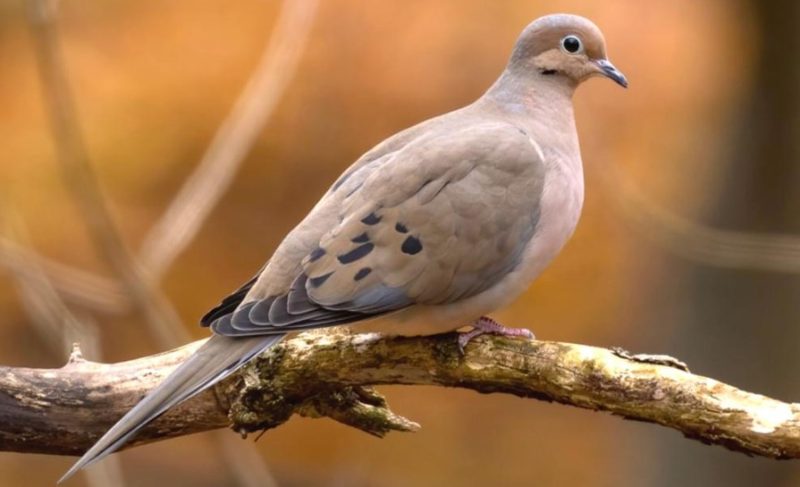
The Mourning Dove is a slender, soft-colored bird with light gray and tan plumage, a small head, and a long pointed tail with white edges. Their gentle appearance is matched by their soft, mournful cooing that often echoes from rooftops or wires.
These birds are frequently seen perched on power lines or feeding on seeds scattered beneath feeders. Their takeoff produces a sharp whistling sound from their wings, which can be startling but is unique to the species. Mourning Doves are known for their swift, direct flight.
In Missouri, they nest in trees, shrubs, or even on hanging planters, and can raise multiple broods each year. They are widespread across both rural and suburban areas and are common year-round. Mourning Doves are well-adapted to life in USDA zones 5 through 7.
Downy Woodpecker
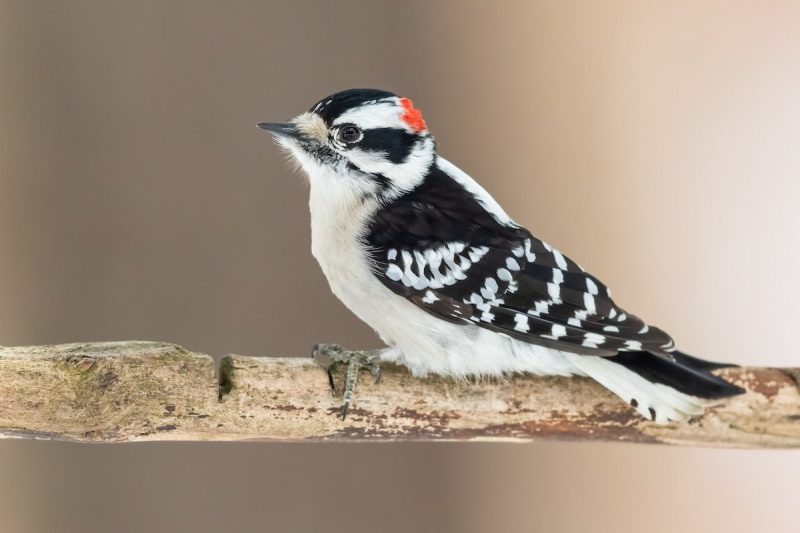
The Downy Woodpecker is the smallest woodpecker in North America, measuring just about 6 inches long. It has a black-and-white plumage with a distinct checkered pattern on its wings. Males can be identified by a small red patch on the back of the head, while females lack the red marking.
These birds are agile and often climb tree trunks or small branches in search of insects. They also eat berries and seeds and are regular visitors at backyard feeders, especially suet in winter. Their call is a short, sharp “pik” and a descending whinny-like trill.
Downy Woodpeckers are found throughout Missouri in woodlands, parks, and suburban yards with mature trees. They adapt well to both urban and rural areas and are year-round residents in USDA zones 5 through 7. Their small size and gentle behavior make them a favorite among birdwatchers.
Red-bellied Woodpecker
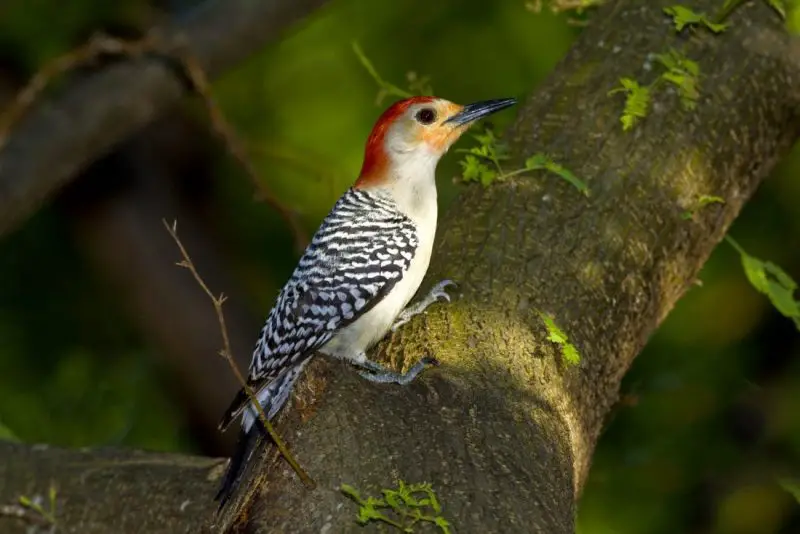
The Red-bellied Woodpecker is a medium-sized bird with a pale face, red crown and nape, and a boldly barred black-and-white back. Despite its name, the reddish tinge on the belly is often faint and hard to see. Its long, chisel-like bill is perfectly suited for tapping into bark.
These woodpeckers are loud and vocal, frequently calling out with a rolling “churr” sound. They are skilled foragers, prying insects from tree bark, but they also enjoy nuts, fruit, and suet. At feeders, they may dominate smaller birds with their assertive behavior.
Red-bellied Woodpeckers are widespread across Missouri and favor hardwood forests, wooded suburbs, and parks. They are common in both rural and urban settings and are non-migratory residents throughout the state, particularly in USDA zones 5 to 7.
Tufted Titmouse
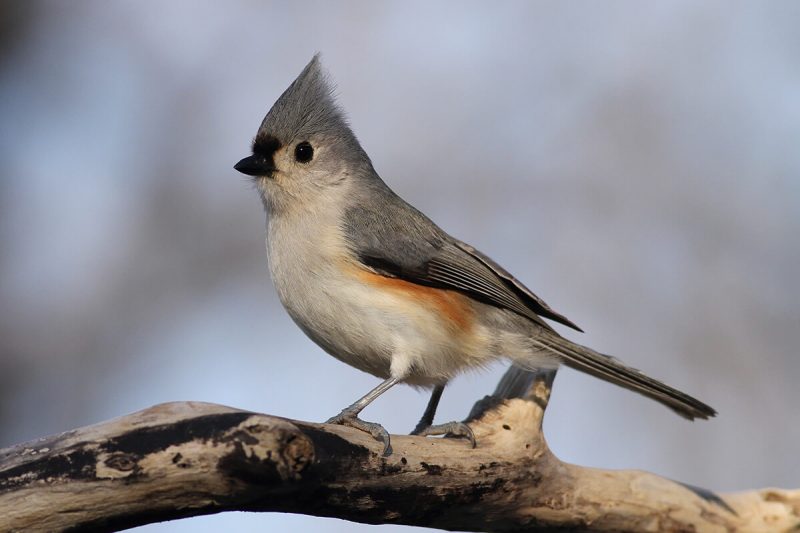
The Tufted Titmouse is a small, gray songbird with a distinctive pointed crest and large black eyes. It has a pale underside with a peach wash on the sides and a black patch above the bill. Its soft coloring and expressive face give it a friendly appearance.
These birds are curious and active, often traveling in mixed flocks with chickadees and nuthatches. They are frequent visitors at feeders, especially for sunflower seeds and suet. Their call is a whistled “peter-peter-peter” that is often heard in wooded yards.
Tufted Titmice are found throughout Missouri in deciduous forests, residential neighborhoods, and parks. They are cavity nesters and will use nest boxes. These birds are year-round residents in USDA hardiness zones 5 through 7 and are well adapted to suburban life.
Carolina Chickadee
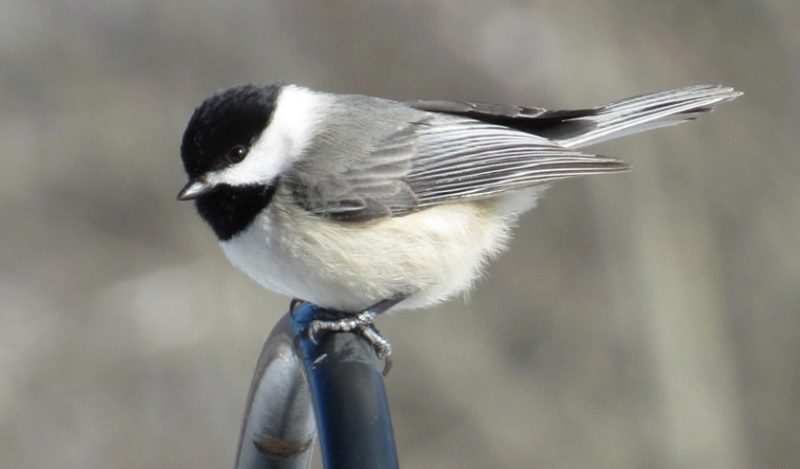
The Carolina Chickadee is a small, energetic bird with a black cap and bib, white cheeks, and soft gray wings. It measures about 4.75 inches long and is quick and nimble in its movements. It can be confused with the Black-capped Chickadee, but the Carolina species is more common in Missouri.
Known for their cheerful “chick-a-dee-dee-dee” call and complex songs, these birds are highly social and often join mixed-species flocks. They frequently visit feeders, especially those with sunflower seeds, suet, and peanut bits. Chickadees also cache food to retrieve later.
Carolina Chickadees live in woodlands, suburban yards, and gardens across Missouri. They nest in tree cavities or nest boxes and are year-round residents. These birds are well-suited to USDA zones 6 and 7, thriving in areas with mature trees and good cover.
American Goldfinch
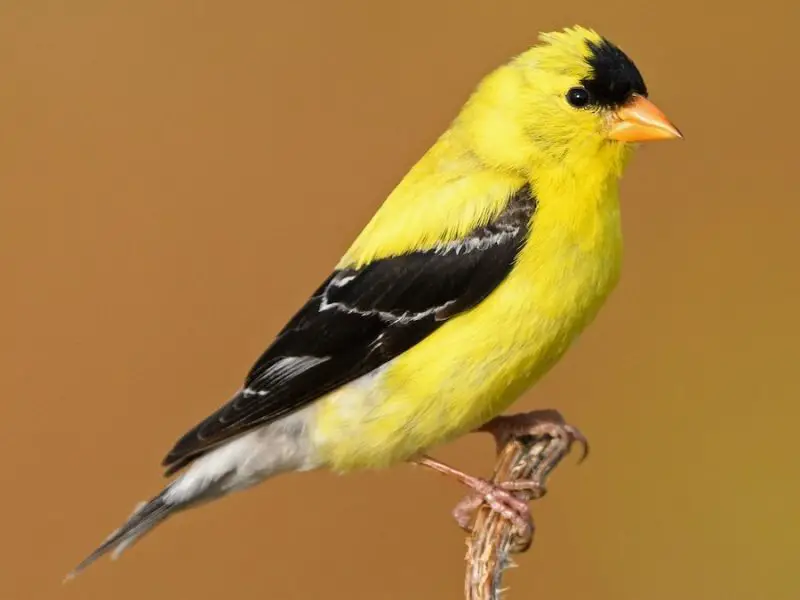
The American Goldfinch is a small, vibrant bird that undergoes dramatic seasonal changes in appearance. Males are bright yellow with black wings and a black cap during summer, while females are duller with olive tones. In winter, both sexes molt into muted brownish plumage.
Goldfinches are known for their bouncy, undulating flight and cheerful “per-chick-o-ree” calls. They feed primarily on seeds and have a special fondness for thistle and sunflower seeds. At feeders, they often cling to tube feeders and are most active in late summer and fall.
These finches are found statewide in Missouri in open fields, meadows, and backyard gardens. They breed later than most birds, often waiting until midsummer when seed sources are abundant. American Goldfinches are common residents across USDA zones 5 through 7, although some may migrate farther south in harsh winters.
House Finch
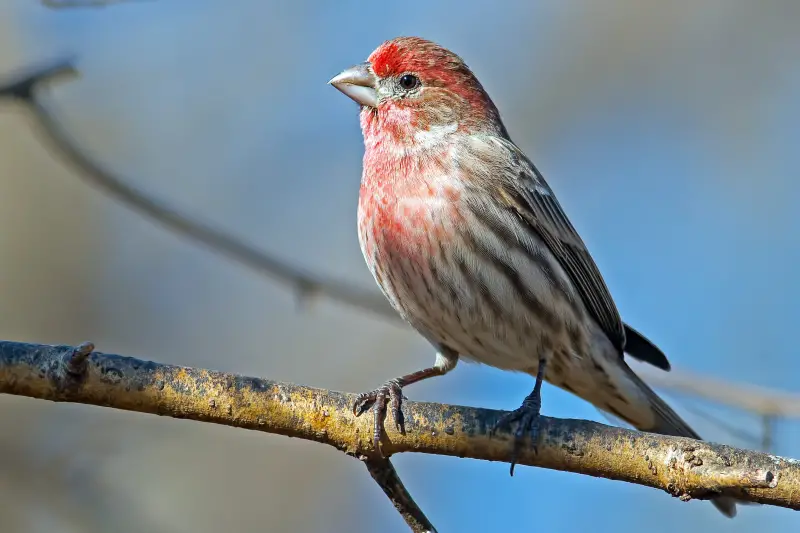
The House Finch is a small, sociable songbird with a short, thick beak and a lively presence. Males display a red-washed forehead, throat, and chest, which contrasts with their brown-streaked bodies. Females lack the red coloring and are streaked in brown and gray.
These finches are commonly seen at feeders, especially those offering sunflower seeds or nyjer. Their warbling song and friendly behavior make them regular visitors in urban and suburban settings. House Finches often travel in small flocks and are active throughout the day.
They are well established across Missouri in cities, towns, and rural areas. Originally native to the western U.S., they’ve successfully spread eastward and adapted to human environments. House Finches remain in the state year-round and thrive in USDA zones 5 to 7.
White-breasted Nuthatch
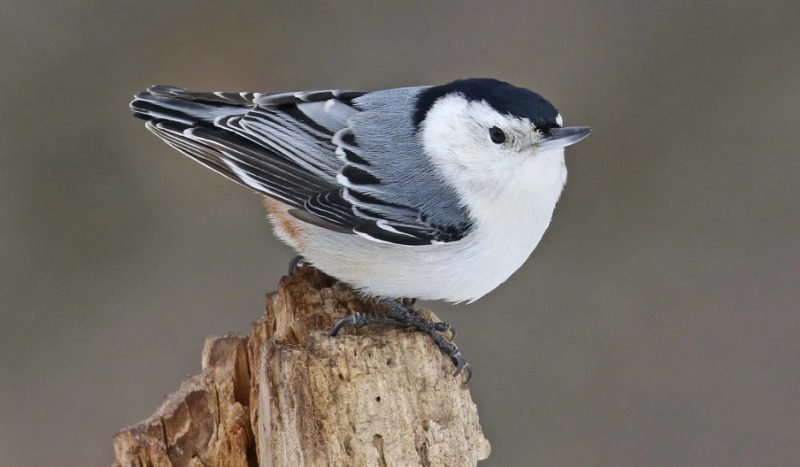
The White-breasted Nuthatch is a compact bird with a clean white face and belly, blue-gray back, and a black or dark gray cap. It has a slightly upturned bill and a short tail. This species is easily recognized by its habit of creeping headfirst down tree trunks.
Nuthatches are curious and acrobatic, often found foraging for insects, seeds, and nuts on tree bark. Their nasal “yank-yank” call is a familiar sound in wooded neighborhoods. They frequently visit feeders for sunflower seeds and peanuts and often tuck food away for later use.
These birds are common throughout Missouri in mature deciduous forests, wooded yards, and parks. They nest in cavities and use both natural tree holes and nest boxes. The White-breasted Nuthatch is a year-round resident in USDA zones 5 through 7.
European Starling
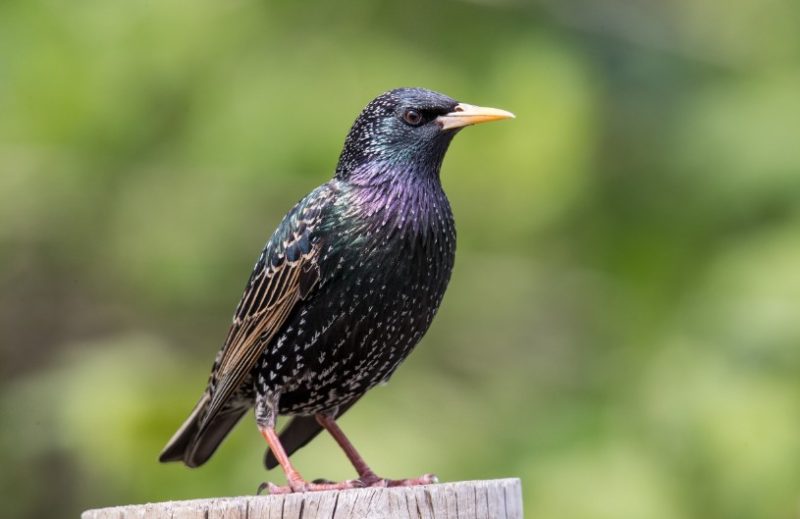
The European Starling is a medium-sized bird with glossy black plumage that shimmers with iridescent green and purple in sunlight. In winter, their feathers are speckled with white spots. They have a sharp yellow bill during breeding season that turns darker in winter.
Highly social and adaptable, starlings are often found in noisy flocks, especially in open fields, parking lots, and city areas. Their harsh, varied calls and ability to mimic other birds make them quite vocal. They are aggressive competitors for nesting sites and displace native species.
European Starlings are abundant across all regions of Missouri. Introduced from Europe, they have thrived in both rural and urban landscapes. They are permanent residents throughout the state and are especially prevalent in USDA hardiness zones 5 and 6.
Dark-eyed Junco
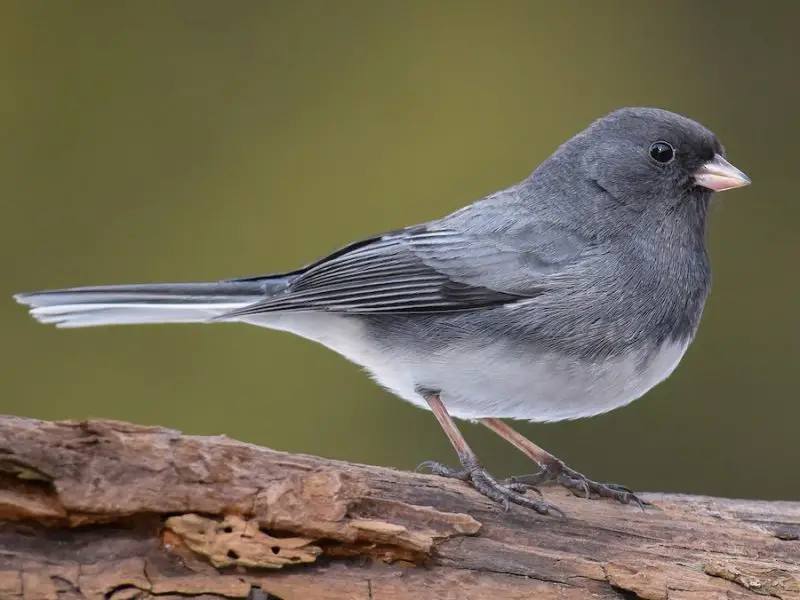
The Dark-eyed Junco is a small, round bird with slate-gray upperparts, a pale belly, and a pinkish bill. Some individuals have darker heads or brownish tones depending on their regional variation, but all share a clean contrast between the upper and lower body.
These birds are primarily seen in Missouri during the colder months. They forage on the ground in flocks, hopping and scratching for seeds beneath feeders or under shrubs. Their quiet trills and flashing white outer tail feathers are characteristic when they fly.
Dark-eyed Juncos breed in northern forests and high elevations but migrate south to Missouri for the winter. They are common in backyards, forest edges, and parks during this season. Their presence is a sure sign of winter in USDA zones 5 through 7.
Brown-headed Cowbird

The Brown-headed Cowbird is a stocky blackbird with a short tail and thick bill. Males have glossy black plumage with a distinct brown head, while females are smaller and entirely streaky brown. Their subtle appearance can make them blend in among other ground-feeding birds.
Cowbirds are usually found feeding on the ground in open fields, lawns, and under bird feeders. They eat seeds and insects and often forage alongside sparrows and blackbirds. Though not aggressive at feeders, they can appear in large flocks and consume food quickly.
This species is best known for its brood parasitism—females lay their eggs in the nests of other birds, leaving the host species to raise the chicks. Brown-headed Cowbirds are widespread across Missouri in both rural and suburban areas, especially in USDA zones 5 through 7.
Chipping Sparrow
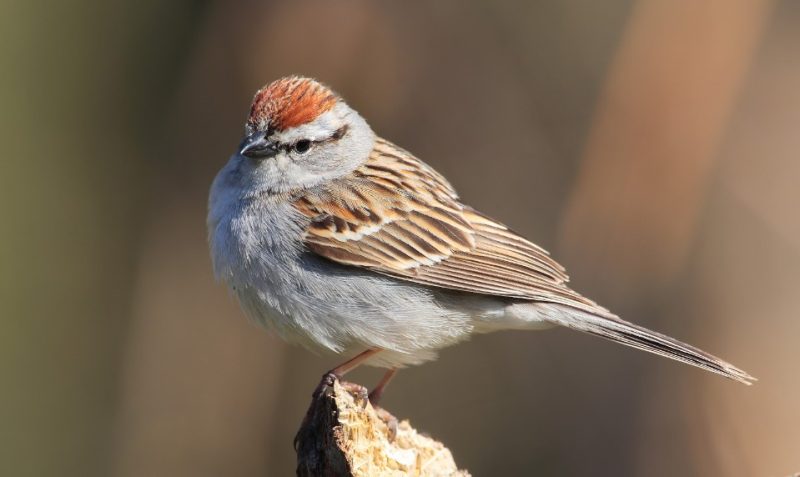
The Chipping Sparrow is a small, neat-looking sparrow with a bright rufous crown, black eye-line, and clear gray breast. Its slim body and short bill give it a delicate appearance. In non-breeding plumage, the crown becomes duller, but the overall shape remains the same.
These sparrows are frequently seen flitting through open lawns, low shrubs, and garden edges. They forage mainly on the ground for seeds and insects and often visit feeders in small flocks. Their song is a rapid, mechanical trill that is easy to recognize in spring.
Chipping Sparrows breed throughout Missouri in open woodlands, backyards, and parks. They are migratory birds, appearing in large numbers in spring and summer and moving farther south for the winter. Their preferred habitat makes them common visitors in USDA zones 5 to 7.
Song Sparrow
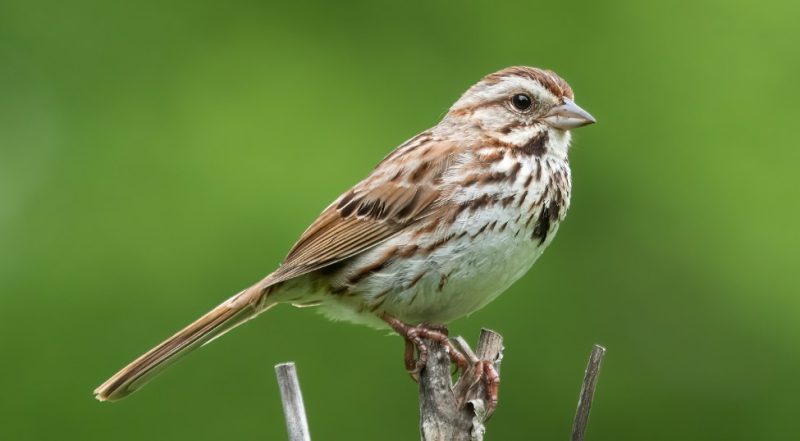
The Song Sparrow is a medium-sized, streaky brown bird with a gray face and a dark spot in the center of its chest. It has a rounded tail and a sturdy build. Though variable in appearance, most Song Sparrows in Missouri show strong breast streaking and a warm brown back.
True to its name, this bird is best known for its rich and melodious song—a series of clear notes followed by trills and buzzes. Males sing frequently during the breeding season from exposed perches. They are also highly adaptable and can be found in many habitats.
Song Sparrows are year-round residents in Missouri and are especially common in brushy fields, wetland edges, and backyard hedges. They feed on seeds and insects and often scratch in leaf litter. These birds are well suited to USDA zones 5 through 7.
Northern Flicker
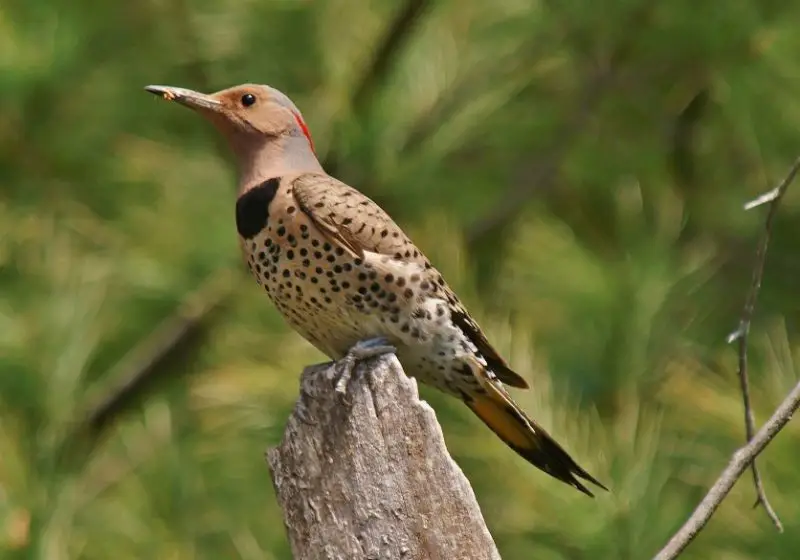
The Northern Flicker is a large, ground-foraging woodpecker with a brownish body covered in black spots, a black crescent on the chest, and a white rump. In flight, its bright yellow underwings and tail feathers are highly visible, especially in the “yellow-shafted” form found in Missouri.
Unlike most woodpeckers, flickers often feed on the ground, probing for ants and beetles with their long, curved bill. They also visit suet feeders and tree trunks. Their call is a loud “kleer” and their drumming is slower and more rhythmic than other woodpeckers.
Northern Flickers nest in tree cavities and prefer open woodlands, forest edges, and suburban areas with scattered trees. They are commonly seen throughout Missouri and are permanent residents in much of the state, especially in USDA zones 5 through 7.
Eastern Towhee
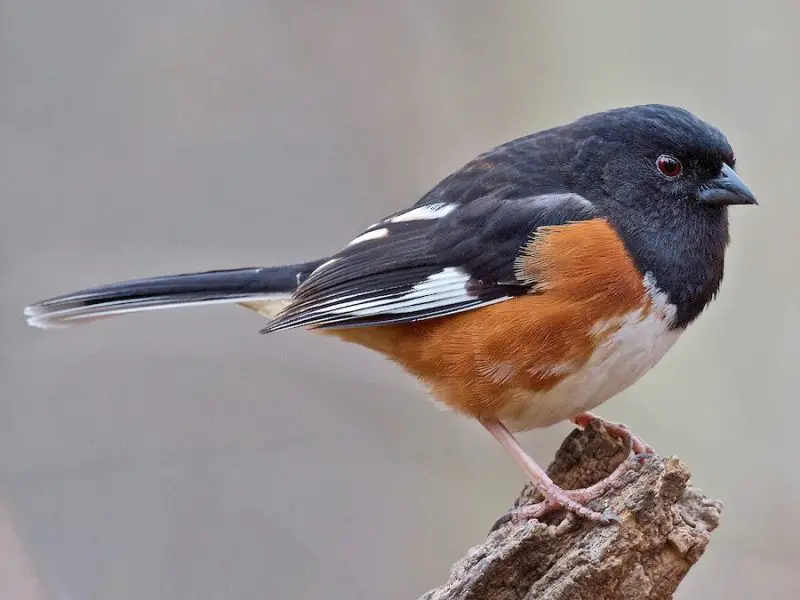
The Eastern Towhee is a striking bird with black upperparts (in males), warm rufous sides, and a white belly. Females are similarly marked but more brown than black. Their large size, red eyes, and long tail make them easy to distinguish from other sparrows.
These birds are most often heard before they’re seen. Their song is a clear and bold “drink-your-tea!” followed by a sharp call note. Towhees spend much of their time on the ground, scratching in leaf litter under shrubs and brush piles in search of insects and seeds.
Eastern Towhees are fairly common in shrubby fields, forest edges, and overgrown gardens across Missouri. They are more secretive than other backyard birds but will visit feeders near dense vegetation. They breed throughout the state in USDA zones 5 to 7.
House Sparrow
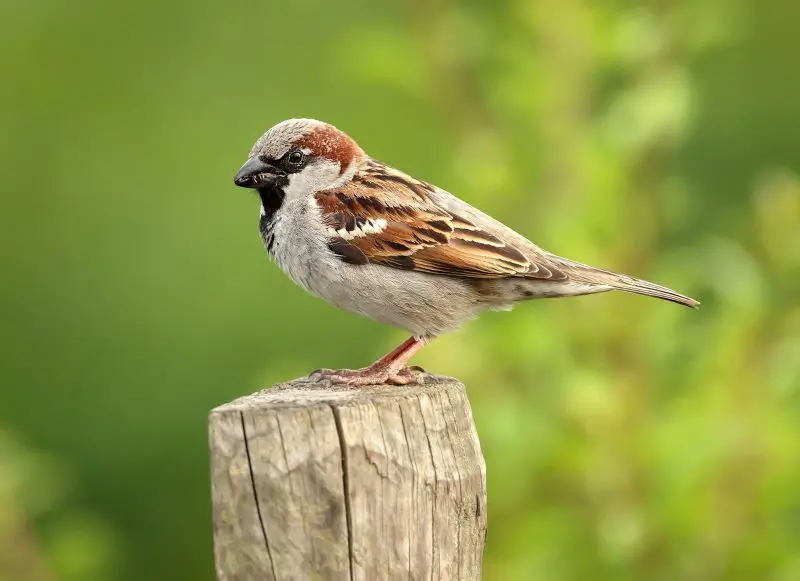
The House Sparrow is a small, chunky bird with a thick bill and short tail. Males have gray crowns, black bibs, and chestnut-colored napes, while females are dull brown with subtle streaking and a pale eyebrow line. Though not native to North America, they have become widespread and abundant.
These sparrows are highly adaptable and often nest in crevices of buildings, gutters, and under eaves. They feed on grains, crumbs, and seeds, and are frequent visitors to backyard feeders. Their chirping calls are loud and constant, especially during nesting season.
House Sparrows are found throughout Missouri in urban, suburban, and rural areas. They thrive in human environments and are among the most commonly seen birds near homes and public spaces. They are permanent residents in USDA zones 5 through 7.
Cedar Waxwing
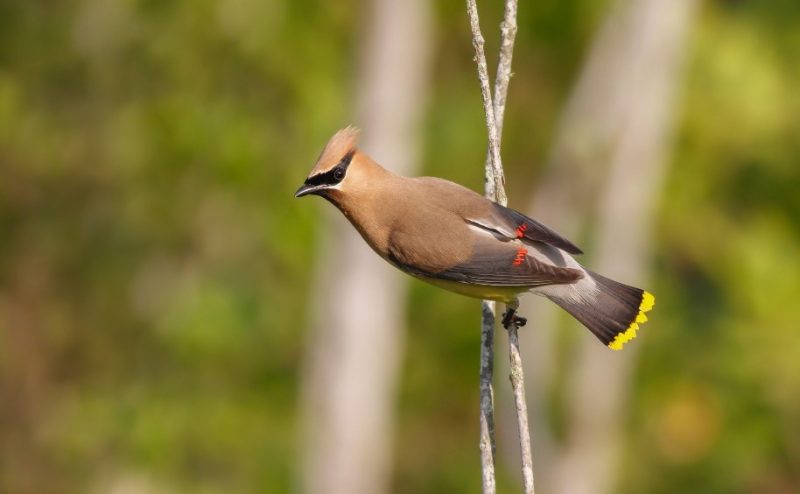
The Cedar Waxwing is a sleek, medium-sized bird with soft, brown plumage, a black eye mask, and yellow-tipped tail feathers. Its crest and smooth feathers give it a silky appearance. Some birds have bright red wax-like tips on their secondary wing feathers.
These birds are highly social and often travel in flocks. They feed mainly on berries and fruit and can be seen swallowing small fruits whole. Their high-pitched, thin calls are often the first sign of a nearby flock. They will also come to birdbaths and water features.
Cedar Waxwings are found in Missouri year-round but are more visible during certain seasons when fruit is plentiful. They prefer orchards, wooded edges, parks, and suburban areas. Their range includes USDA zones 5 to 7 across the state.
Common Grackle
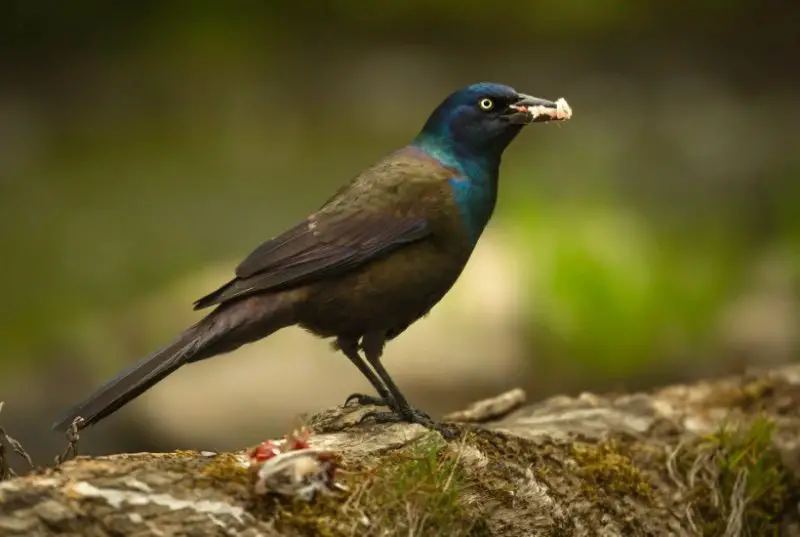
The Common Grackle is a large, glossy blackbird with an iridescent sheen that reveals hues of blue, green, or purple in sunlight. It has long legs, a strong, tapered bill, and a long tail. One of its most striking features is its piercing, pale yellow eyes.
Grackles are often seen in large, noisy flocks, especially during migration and winter months. They forage on the ground for insects, seeds, and scraps, and will visit feeders, especially for cracked corn and sunflower seeds. Their call is a loud, metallic “squawk.”
These birds are common in fields, wetlands, city parks, and suburban areas throughout Missouri. They nest in trees or shrubs and often roost in large communal groups. Common Grackles are permanent residents in much of the state, especially in USDA zones 5 through 7.
Baltimore Oriole
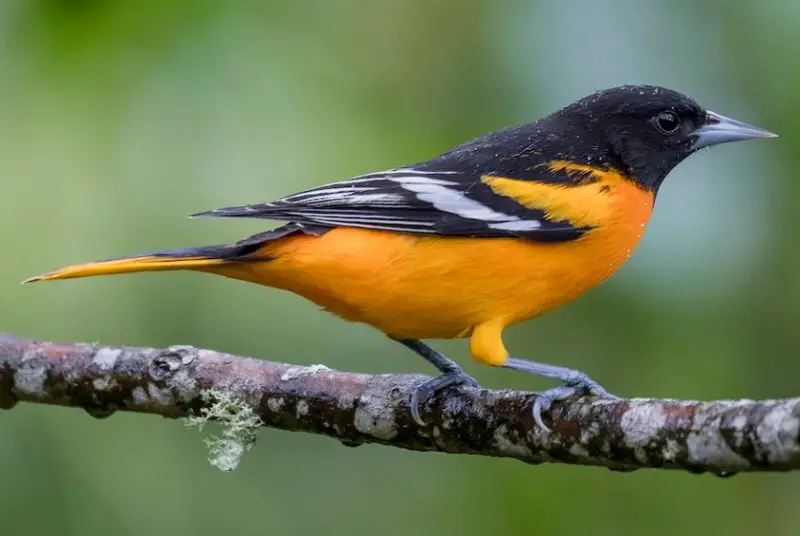
The Baltimore Oriole is a vibrant, medium-sized songbird known for its brilliant orange and black plumage. Males are especially striking with deep orange undersides and jet-black heads, backs, and wings. Females are paler with yellow-orange coloring and grayish backs.
These orioles are often heard before they are seen, thanks to their clear, flute-like songs. They are attracted to sugary foods and are known to visit feeders with oranges, jelly, or nectar in spring and summer. They also feed on insects and fruit in the canopy.
Baltimore Orioles migrate to Missouri during the warmer months to breed. They prefer open woodlands, forest edges, and shade trees in residential areas. Their hanging, woven nests can often be found dangling from tree branches. They are seasonal visitors in USDA zones 5 through 7.
Ruby-throated Hummingbird
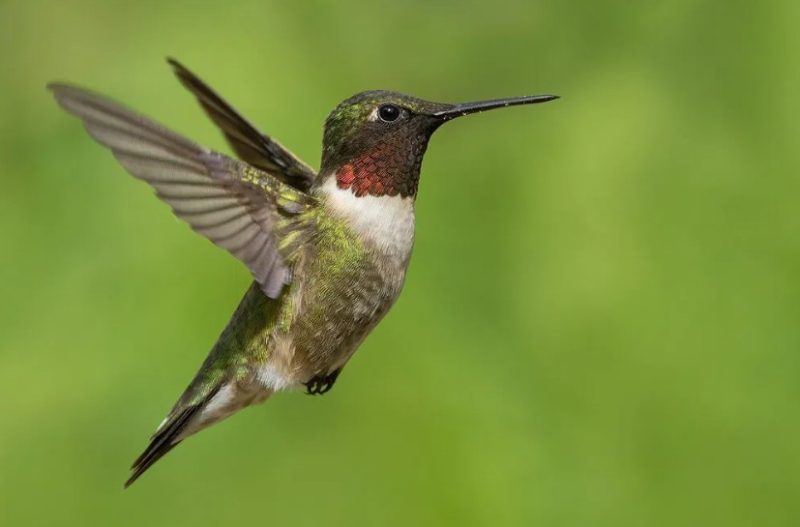
The Ruby-throated Hummingbird is Missouri’s only regularly breeding hummingbird species. Males have a brilliant ruby-red throat that flashes in the sunlight, along with green backs and white underparts. Females lack the red throat and are more subtly colored.
These tiny birds are fast and agile, hovering to feed on nectar from flowers and feeders. They also consume small insects and spiders for protein. Their wings beat rapidly, producing a humming sound, and they are known for their territorial behavior around feeders.
Ruby-throated Hummingbirds migrate to Missouri in spring and stay through late summer. They breed in woodlands, gardens, and suburban yards where flowers and nectar feeders are abundant. Their presence is most noticeable in USDA zones 5 through 7 during the warmer months.
Frequently Asked Questions About Backyard Birds in Missouri
What are the most common backyard birds in Missouri?
Missouri is home to a wide variety of backyard birds throughout the year. Some of the most common species include the Northern Cardinal, American Robin, Blue Jay, Mourning Dove, and House Finch. In winter, Dark-eyed Juncos become more visible, while species like the Baltimore Oriole and Ruby-throated Hummingbird appear during warmer months. Feeders, birdbaths, and native vegetation help attract these birds to your yard.
When is the best time to watch backyard birds in Missouri?
Backyard birdwatching can be enjoyed year-round in Missouri. Spring and fall are especially active times due to migration, bringing in a mix of seasonal visitors and resident species. In summer, look for brightly colored birds like goldfinches and hummingbirds, while winter months offer clear views of chickadees, woodpeckers, and nuthatches as they gather at feeders. Early mornings tend to be the best time of day for bird activity.
What should I feed backyard birds in Missouri?
Different bird species prefer different foods, but black oil sunflower seeds are a favorite among cardinals, finches, and chickadees. Suet is popular with woodpeckers, wrens, and nuthatches, especially in winter. Thistle (nyjer) seed attracts goldfinches and siskins, while fruit or jelly can bring in orioles and waxwings. Hummingbirds visit nectar feeders filled with a simple sugar-water mix (no red dye needed).
How can I attract more birds to my Missouri yard?
To attract more birds, offer a mix of food sources, clean water, shelter, and native plants. Install feeders at various heights, provide birdbaths or shallow water dishes, and grow shrubs or trees that offer nesting spots and berries. Avoid using pesticides, which reduce insect food for many birds. Consistency—keeping feeders full and water clean—is key to keeping birds returning.
Are any backyard birds in Missouri migratory?
Yes, many backyard birds in Missouri are migratory. Ruby-throated Hummingbirds, Baltimore Orioles, Chipping Sparrows, and Cedar Waxwings migrate seasonally. Others, like the American Robin and Eastern Bluebird, may migrate depending on weather and food availability. Watching for these seasonal changes can make birdwatching in Missouri especially rewarding throughout the year.
Do backyard birds in Missouri nest near homes?
Many Missouri birds nest close to human dwellings. House Sparrows, Carolina Wrens, and Eastern Bluebirds frequently use man-made nest boxes or crevices in buildings. Robins and doves often build nests on ledges, porch lights, or tree branches near homes. Providing nest boxes and leaving natural brush or trees intact can encourage nesting activity.
What should I do if I find a baby bird in my yard?
If you find a baby bird, first determine if it’s a nestling (with little to no feathers) or a fledgling (fully feathered and learning to fly). Nestlings should be returned to the nest if possible. Fledglings should be left alone unless they are in immediate danger, as their parents are usually nearby. Avoid feeding or handling wild birds, and contact a local wildlife rehabilitator if you’re unsure.
Are bird feeders safe during the winter in Missouri?
Yes, bird feeders are especially important in Missouri during winter when natural food sources are limited. Offering high-fat, high-protein foods like suet, sunflower seeds, and peanuts helps birds maintain energy. Keep feeders clean and dry, and provide fresh water when temperatures dip below freezing. A heated birdbath can be a valuable resource in cold weather.
How do I prevent unwanted birds like starlings and grackles?
European Starlings and Common Grackles are known to take over feeders and drive away smaller birds. To deter them, use feeders designed for smaller birds (like tube feeders with small perches) and avoid offering foods they prefer, such as cracked corn. Providing a variety of feeder types in different locations can help reduce competition among species.
Is it okay to offer bread to backyard birds?
It’s not recommended to feed bread to birds. Bread lacks the nutrients birds need and can lead to health problems, especially if consumed in large amounts. Instead, offer natural, nutrient-rich foods like seeds, suet, fruit, or nectar. Fresh foods and clean water are much better for supporting healthy bird populations in your Missouri yard.

